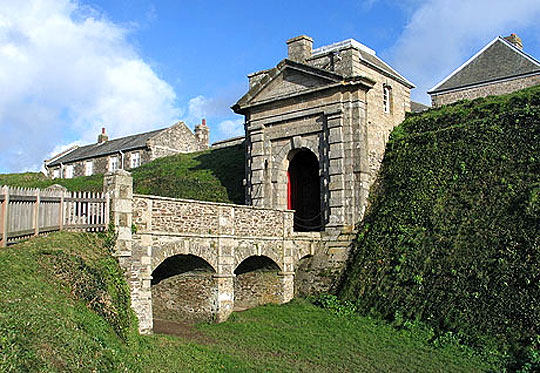Significance of Pendennis Castle
The defences on the headland at Pendennis, along with those of the wider area defending the Fal at St Mawes and at St Anthony Head, represent one of the finest surviving examples of a coast fortress in England. Successive remains chart developments in military engineering and weapons technology and the organisation of coast defence from the Tudor period until the Second World War.

Henry VIII and Pendennis
The gun tower (and its surrounding gun platform, or chemise) is one of only nine structures on the south and east coasts of England built between 1539 and 1545 to a centrally planned design as part of the first national coast defence policy. Its very distinctive circular form, designed for tiered, all-round defence, was quickly eclipsed by new fort designs that employed the angle bastion.
As a result, the Henrician gun tower is a rare example among late medieval and early modern artillery fort designs, illustrating one important, short-lived and distinctly English application of gunnery for coast defence.
The Elizabethan Fortress
Pendennis is a fine and early example in England of a fortress using the angle bastion system, in which the bastions, or low artillery platforms, were designed to allow for firing both at distant targets (from their outward-facing sides) and along the defences themselves (from their short flanks). Crucially, each bastion provided covering and overlapping fire for the adjacent curtain walls, bastions and approaches, thereby eliminating blind spots from defensive fire and exposing attackers in any position to fire from several locations.
Furthermore, Pendennis is one of only a few locations in England where substantial bastioned forts were built during the late 16th century: a second, of comparable scale, is at Carisbrooke Castle, Isle of Wight, and a third, more massive enterprise, at Berwick-upon-Tweed, Northumberland. Other forts involving early experiments with the angle bastion survive at Star Castle and Harry's Walls at St Mary's in the Isles of Scilly, and at Yarmouth Castle on the Isle of Wight.
The Elizabethan ramparts at Pendennis are therefore also of a very rare type[1] and Pendennis is the only place in England where the bastioned defence system can be seen in tandem with the earlier Henrician system.
Guard Barracks
The Guard Barracks are an early and rare example of barrack building by the Office of Ordnance at the turn of the 18th century.[2]
Breech-Loading Gun Batteries
The remains of gun emplacements at Pendennis illustrate the transition from gun batteries using smooth-bore guns to those using breech-loading weapons. The evidence here is particularly well preserved. Alongside the older ramparts pierced by embrasures for smooth-bore weapons (Nine-Gun Battery, Smithwick Bastion) are the late Victorian and 20th-century emplacements for breech-loading guns (One-Gun Battery, Half-Moon Battery, the batteries at Crab Quay, East Bastion and Carrick Mount Bastion) that were developed to counter all types of seaborne attack.
These included light quick-firing guns, heavier breech-loading guns on the short-lived hydro-pneumatic 'disappearing' carriage (One-Gun Battery is one of the few surviving examples, and perhaps the finest), and advanced 6-inch breech-loading guns on fixed carriages employing horizontal recoil, which remained in active service until 1956.
Other important remains at Pendennis include structures involved with the crucial fire control arrangements that co-ordinated the action of the guns during the Second World War, such as the Battery Observation Post and the Battery Plotting Room.[3]
READ MORE ABOUT PENDENNIS CASTLE
Footnotes
1. For the Tudor period see A Saunders, Fortress Britain: Artillery Fortification in the British Isles and Ireland (Liphook, 1989), 34–69.
2. For barrack building see J Douet, British Barracks, 1660–1914: Their Architecture and Role in Society (London, 1997).
3. R Linzey, Fortress Falmouth: A Conservation Plan for the Historic Defences of Falmouth Haven, 2 vols (London, 2000), is particularly thorough on the breech-loading era.